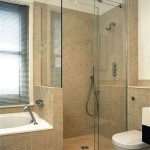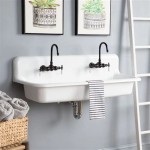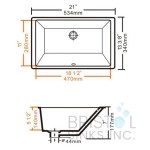Optimizing Bathroom Storage: Under the Sink Solutions
The bathroom, often one of the smallest rooms in a home, frequently presents a significant storage challenge. Efficiently utilizing available space is crucial for maintaining a tidy and functional bathroom environment. The under-sink area, commonly overlooked or underutilized, offers a prime opportunity for maximizing storage capacity. Implementing thoughtful storage solutions beneath the sink can dramatically enhance organization and streamline daily routines.
A well-organized under-sink area contributes to a more pleasant and efficient bathroom experience. Without dedicated storage, cleaning supplies, toiletries, and personal care items tend to accumulate haphazardly, leading to clutter and difficulty in locating needed items. This disorganization can result in wasted time, frustration, and even the unnecessary purchase of duplicates. Optimizing the under-sink space promotes a sense of order and accessibility, simplifying cleaning and personal grooming tasks.
Several factors contribute to the challenges of organizing under-sink storage. The presence of plumbing, including pipes and drain lines, often restricts available space and creates awkward configurations. Moisture and humidity levels in the bathroom environment can also pose a threat to stored items, particularly paper products and certain types of containers. Furthermore, the limited accessibility of the under-sink area makes it prone to becoming a repository for infrequently used items, further compounding the clutter problem. Addressing these challenges requires a strategic approach, incorporating appropriate storage solutions and organizational strategies.
Addressing Plumbing Obstacles and Utilizing Vertical Space
The configuration of plumbing is a primary consideration when planning under-sink storage. Pipes and drain lines often occupy a significant portion of the available space, requiring creative solutions to maximize storage capacity. Instead of viewing these obstructions as limitations, consider incorporating storage solutions designed to work around them. U-shaped shelves, for instance, are specifically designed to fit around drain pipes, providing usable shelf space without sacrificing accessibility. Similarly, drawer dividers can be configured to accommodate pipes and prevent items from sliding around.
Vertical space is often underutilized in the under-sink area. Stacking shelves or tiered organizers can significantly increase storage capacity without expanding the footprint. These solutions allow for efficient organization of items based on frequency of use, with frequently accessed items placed on lower shelves and less frequently used items stored higher up. Adjustable shelves offer further flexibility, allowing for customization to accommodate items of varying sizes. When selecting shelving units, it is crucial to consider the height of the available space and the depth of the cabinet to ensure a proper fit.
Hanging organizers, attached to the cabinet door or the side walls, provide additional storage for smaller items such as cleaning cloths, sponges, and hair accessories. These organizers help to free up shelf space and keep frequently used items within easy reach. Over-the-door organizers with multiple pockets are particularly useful for storing a variety of items, from hair styling tools to personal care products. When installing hanging organizers, ensure that they do not interfere with the closing of the cabinet door or obstruct access to plumbing fixtures.
Selecting Appropriate Storage Containers and Materials
The choice of storage containers plays a significant role in optimizing under-sink organization. Clear plastic bins are a popular option, as they allow for easy identification of contents without requiring labels. Bins with lids help to protect items from moisture and dust, extending their shelf life and preventing spills. When selecting plastic bins, opt for durable, BPA-free materials that can withstand the rigors of daily use. Avoid using cardboard boxes or other materials that are susceptible to moisture damage.
Mesh baskets offer another versatile storage solution, particularly for items that require ventilation. These baskets are ideal for storing damp sponges, cleaning cloths, and hair styling tools. The open weave design allows for air circulation, preventing the growth of mold and mildew. Mesh baskets are also lightweight and easy to clean, making them a practical choice for the bathroom environment. Consider using different sized baskets to accommodate items of varying sizes and shapes.
Drawer dividers are essential for maintaining order within drawers and preventing items from becoming jumbled together. These dividers can be made from plastic, wood, or fabric, and are available in a variety of sizes and configurations. Adjustable drawer dividers offer the most flexibility, allowing for customization to fit the specific needs of the user. Drawer dividers are particularly useful for organizing toiletries, makeup, and other small personal care items. Proper drawer organization helps to prevent items from becoming lost or damaged and makes it easier to locate needed items quickly.
Maintaining Cleanliness and Preventing Moisture Damage
Maintaining cleanliness is crucial for preventing the growth of mold and mildew in the under-sink area. Regular cleaning helps to remove accumulated dirt, dust, and spills, creating a more hygienic environment. Wipe down shelves and containers with a damp cloth and mild detergent on a regular basis. Address any spills immediately to prevent staining and odor buildup. Consider using a moisture-absorbing mat or liner on the bottom of the cabinet to protect against leaks and condensation.
Proper ventilation is essential for reducing moisture levels in the bathroom. Ensure that the bathroom is adequately ventilated during and after showering or bathing. Use an exhaust fan to remove excess moisture from the air. Consider leaving the bathroom door slightly ajar to promote air circulation. Dehumidifiers can also be used to control humidity levels in the bathroom, particularly in areas with poor ventilation.
Storing items susceptible to moisture damage in airtight containers can help to protect them from humidity. Paper products, such as toilet paper and tissues, should be stored in sealed plastic bins or bags. Similarly, medications and other sensitive items should be stored in airtight containers to prevent them from becoming damaged by moisture. Consider using desiccant packets to absorb excess moisture within storage containers. Regularly inspect stored items for signs of moisture damage, such as discoloration or mold growth, and discard any affected items.
Effective under-sink storage in the bathroom requires a multifaceted approach. Addressing plumbing limitations, maximizing vertical space, selecting appropriate storage solutions, and maintaining cleanliness are all essential for creating a functional and organized bathroom environment. By implementing these strategies, individuals can transform the under-sink area from a neglected space into a valuable storage asset, contributing to a more pleasant and efficient bathroom experience. Thoughtful planning and consistent maintenance are key to maximizing the benefits of under-sink storage and maintaining a tidy and organized bathroom.

Bathroom Under Sink Starter Kit The Container

35 Bathroom Storage Ideas To Maximize Every Square Inch Of That Teeny Tiny Space

Diy Pull Out Under The Bathroom Sink Storage Hamilton Park Home Inspiration For Garden

How To Organize Your Under Bath Sink Cabinet The Container

Wire Baskets Are Great Ways To Keep Your Bathroom And Kitchen Sink Cabinets Organized

Kleankin Bathroom Sink Cabinet Freestanding Under White

Buy Garda Textured Under Sink Storage Unit From The Laura Ashley

Kleankin Pedestal Sink Storage Cabinet Bathroom Under With 2 Doors And Open Shelf Vanity Grey 834 431gy

Norsk High Gloss Under Sink Cabinet Homesavers

Bathroom Under Sink Cabinet Rustic Oak Wooden Storage Cupboard Unit New







